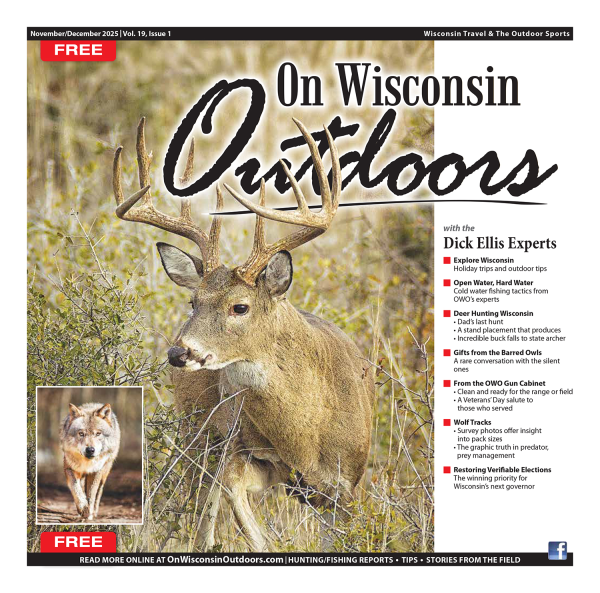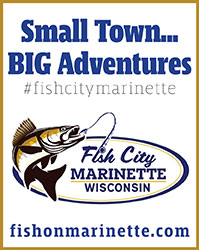Legends in the Highway 8 Woods
I’ve struggled to come to grips with the events that have been playing out along the roadways of my childhood home in Barron County. If there is any saving grace in the sorrow, it’s that the rural communities of northwest Wisconsin have come together with boundless emotion and love to make sense of a real-life tragedy and to find a missing child.
The following story, along with my brother’s map sketch, was meant to relate the perspective of two kids growing up in a diverse and wild land along Highway 8. It was originally designed to be a light-hearted opening in a book, but has since grown to take on a much more compelling task.
My brother Dan and I grew into the world of adulthood in the house that the Closs’s eventually moved into. We spent endless days in those woods, and we burned endless miles up and down the highway sprouting from our home. It still doesn’t seem possible to me that so much pain could grow from a place that knew so many happy times.
I visited with Denise Closs several years back when I was drafting the story. My family was with me, and it was one of those wonderful, autumn mornings that only northwest Wisconsin can offer up. Her own family was kind enough to show us around the old place, and though I’ve long since moved on down the highway, I remember they were the kind of family that made me proud as hell to claim Barron as my original hometown.
I’m a writer. I can’t offer up near enough as law-enforcement efforts and the toils of countless volunteers to find a missing girl. I’ve only got legends and memories, but I pray this piece makes the rounds across the country and keeps the story at the forefront of the media’s attention for as long as it takes to bring Jayme Closs back home to Barron.
- John Luthens, October 25, 2018

Legends in the Highway 8 Woods
Highway 8 was a dividing line; slicing through the state and splitting the tree-shrouded fog in the northern tier of Wisconsin from the rest of the state like a knife culling dark crust from a loaf of fresh bread.
Times have since moved on, and this cut-and-dried orientation may not necessarily be the case today. Being perfectly honest, it probably wasn’t even the case back then. But when I was growing up the blacktopped meridian of Highway 8 was imaginatively presumed to separate the papered fringes of the civilized map from the uncharted wilds, and this geographical fault line was routinely drawn into my head by local elders and coffee-shop quarterbacks who fancied themselves forgotten frontiersman on the cusp of the great divide.
Somewhere far south of Highway 8 lay the world of commerce and government: The fertile fields of the heartland, the Mississippi and Wisconsin Rivers, Eau Claire, Lacrosse, Milwaukee, Madison – the industry captains, the lion’s share of well-paid, blue-collar factory workers and, for good, bad, worse or indifferent (usually for the worse, according to my aforementioned elders), the politicians who made their grimy wages stoking the insatiable tax boilers of Wisconsin’s engine. South of Highway 8, legend had it that the modern world was in full swing.
North was a different story. North of Highway 8 the blacktop ended and flights of fancy took over: lumberjacks plying saws beneath soaring pines, untamed rivers roaring beneath ridges that were littered with the dark, open jaws of mineshafts belching with a history of iron ore and copper. Bottomless lakes splayed open in misted bogs, ringed with mysterious rises and haunted by the spirits of old fishermen who were seldom seen and heard. North of old number 8 lay a wilderness forgotten by both time and congressmen alike. Peeled wooden signs should have leaned in the overgrown weeds on the north side of the highway to say, “Unpaved roads ahead,” “Here there be dragons,” or, at the very least: “Here there be turkeys, wolves and bears.”
My brother and I rose through the ranks of maturity on this storied blade in Barron County, sprouting up along a stretch of oak and aspen forest that crept down the shoulders of the highway for an even half-mile, opening its wooden doors along the grassy ditches towards both the north and south for what seemed to us to be an eternity. I’m not certain to this day who owned the woods on either side, but in the wild-west language of our youth it didn’t really matter one way or another. Private property was an unfathomed adjective-and-noun combination that had no place in the first-edition dictionary of our northern, Highway 8 vocabulary.
We were taught to look both ways before crossing the center line, learning on our own to be respectful in the tangles and glades, never burning or destroying more than we needed for campfires and log cabin forts, and never shooting more squirrels or rabbits with our pellet guns than we could comfortably stuff into our stomachs. If anyone with ownership authority ever spied our wanderings from a distance – they either felt sorry for the ragged creatures in front of them or they flat out didn’t care as long as we weren’t toting chain saws or machine guns, which really amounted to the same thing along the frontier woodlots and cynical yellow lines of Highway 8.
Our earliest childhood blossomed in a small house along one side of the woods on the south side of the highway, our adolescent years in a slightly bigger house on the north side of the road a scant half-mile removed and on the opposite side of the Highway 8 woods. Although I’d like to believe our parents were undaunted by the prejudicial lines of north versus south, and that they fostered both my journalistic tendencies and my brother’s artistic creativity by letting us judge the character of the country and trees on both sides of the highway fence – the unbiased truth was that my brother and I were our own pliable forest of pure, unadulterated energy. My parents had the responsible foresight to understand that they needed a bigger house for their growing boys, but they had doubtless been worn ragged by our antics and lacked the strength to pick up and move any further than absolutely necessary.
The end result of all this moving and shaking across the centerline was that my brother and I spent our youth comparing the woods on both sides of Highway 8. The characteristics between the ingrained notion of north and south were indeed a bit different. But we discovered through the lenses of our own eyes and mind that they were not as pronounced as our superior’s had made them out to be.
Using the Berlin Wall, for instance, as a point of comparison: When the communist bricks came a tumbling down, I’ll warrant that one had to look pretty damn hard to see where the landscape of East Germany turned into West, which may be a bad example for a couple of woods vagrants like us, who would have given you two blank stares if you’d asked us to point out either of the Germanys on a globe, which we really had no use for, other than using it for a backup kickball when our other one went flat.
Putting it into an easier, more naturally flowing perspective, one can move from north to south in the winter and see the snow receding, but there isn’t a clear-cut dividing line where the banks are 3 feet high on one side of the road and the grass and wild flowers are in full bloom on the other. Indeed, wild flowers and grass and snow were colorful concepts our brains could grasp, not nearly as confusing as the black and white lines of latitude and longitude and compass settings, which, once again, we had no use for, based on the fact that we set out on multiple extended hiking forays from our Highway 8 base camp in search of the Canadian border and would have ended up in Illinois if the cookies and sandwiches hadn’t run out.
It was true that south side of the Highway 8 woods tended to be more demographically appealing than the north side: rising oaks shading the sunlight beneath the canopy to offer pleasant strolling without the riff-raff understory of stunted brush to sting the eyes and swat the face; Rolling ridges crackling beneath vaults of fallen leaves, making for the finest games of war and capture the flag, with the rich smells and color of October hanging eternally in the air.
A glacial hill overlooking a sweeping vista of turkey farm fields became a particularly good south-side playground. We built a fort from cast-off logs at the base of the hill along a runoff stream that cut down from the rise, pillaging the log cabin for wood on a regular basis to carve homemade boats for a regatta race in the gully when the water was running high after a good spring rain.
Our boat designs got quite creative, complete with outriggers for maximum stability and dugout seats for our bravest action figures to ride in. Had we continued to pursue our nautical trade in the south woods, it may have led to rubbing shoulders with the boat-shoed, skipper-capped crowd of the rich and famous at some point down the stream of time. Indeed, we may have kept on tacking south seeking glory if not for the fact that the runoff stream washed out into a turkey field, inevitably causing us to moor our wooden yachts to a brush pile and let out a pair of uncivilized whoops that would be highly frowned upon in the private golf courses and structured marinas of high society. When it came to lifestyles of the rich and famous, chasing gobbling flocks of turkeys to and fro across the sparkling green horizon seemed far more befitting to our social rank than unfurling white sails or whacking a tiny ball off a tee.
Older and debatably wiser by the time we moved to the north side of Highway 8, we found ourselves comfortably at home before our feet hit the opposite side of the asphalt. Perhaps we lusted for bigger adventure, or a deeper, philosophical meaning in the chaos, or maybe we’d ravaged our cabin on the south side for so much boat material that the fort had become structurally unsound and unlivable. It’s even a distinct possibility the turkey farmer had phoned our folks to say, “fun is fun, and it’s sure nice to see them playing in the woods, but tell your goddamn kids to quit chasing my flock into feathery splinters!” Whatever the case – it was in the wild tangles of the northern woods that we really began carving our hillbilly keisters into the natural world.
One-hundred yards back of the house, and it was thorn apple and poison sumac heaven. The overgrown remains of a small clearing grew ripe with blackberry bushes and hid an ancient windmill that creaked in the wind and mixed with the rustling of the aspens, cranking out an echo that could be heard from a half-mile distant when the wind was right. The glade had the aura of a forgotten age. No barn or cobbled-farmhouse foundations, no sign that anyone had once homesteaded; just fingers of thorny brush, blackberry tangles, and ominously creaking blades that never quit turning.
And partridges, forgot to mention the partridges. Those feathered bombs loved hiding in the sumac and blackberries, erupting at your feet and stopping your heart in its tracks, which was pretty awesome if you were carrying 12-gauge shotguns, but not so awesome if all you were toting was pretend stick-guns and were already creeped out by a ghostly windmill that refused to die.
The tactical matter of soldiering through the north-side thickets was solved by crawling up a grade on the far end of the prickly, windmill garden and slinging our packs along the rocky gravel of a railway. Death by locomotive might have loomed large on the split-rail horizon of me and my brother’s future if it weren’t for the fact that the barren tracks hadn’t seen too much business ever since the mysterious, oil-shortage depression of the 1970’s had rebounded and the transportation industry once again found it easier and cheaper to rumble goods in semi-trailers along the concrete line of the highway. Walking the tracks years later, I saw tattered signs posted at roadside crossings that said “Tracks Abandoned,” but even back then, the only clatter of evidence to tell that trains indeed existed on the northern frontier was an occasional lonesome whistle deep in the night.
My brother and I coined it the Underground Railroad, woefully naïve of the racial connotation, and only vaguely aware that we’d heard the name bantered about in stuffy, history classrooms where the curriculum was twisted into confusing knots by the same type of high-nose, boardroom mentality that had likely dreamed up the gas shortage boondoggle in the first place. We only knew for certain the name sang of freedom, and that it belonged to hoboes like us. Along the tracks of the Underground Railroad, thoughts of mortality and tragic endings were swept away into the passing woods.
Songbirds fluttered in the thickets and the scurrying of unseen creatures broke the brush as we skipped along uneven, wooden ties. Dark culverts ran beneath and smelled of wet, mysterious secrets. Sunlight cast our shadows upon rocks and gravel as we walked the rails, capturing the essence of escape into passages of the unknown.
Is it possible that the spirits of wayfarers seeking adventure, opportunity and asylum walked beside us with sticks tucked over their shoulders and bundles knotted to the ends? We were too young to know. Like thoughts of meeting a screaming engine head first along the tracks – like thoughts of our own mortality – we had yet to come to tragic grips with those thoughts back then.
The fact that so many wonders could be packed together in the span of a half-mile of northern, highway forest is an unexplained law of nature. There were sandstone cliffs for climbing, rumored to be honeycombed with caves that had long ago been sealed shut for the safety of wandering children. Screw that! We spent hours digging to unearth the entrances. Damned if hidden caves weren’t ripe for holding treasure. We would have blasted the sandstone face to pieces if we’d known where to lay our grubby hands on some Barron County, black-market explosives. Fingers were rubbed raw, countless sets of clothes torn to shreds, but despite working like rabid badgers for countless seasons, no caves were ever found.
Many of our cynical elders claimed the caverns were only Highway 8, backwoods legend to begin with, but I stubbornly believe that if we could have bargained with the devil for one more year in the endless-summer cycles of our youth, we would have discovered the rumored caverns and bought a tropical island with the treasure.
Not that we needed an island, mind you, being that we already possessed one, although calling it a tropical paradise may have been a bit of a stretch. Our island lay due north of Highway 8 and smack in the starboard-center of a cow pasture creek that paralleled the Underground Railroad.
Pilfering rail spikes from the tracks and cutting saplings from the underbrush, we built a wooden bridge to the island and erected roughshod tiki huts to shelter away the summer holidays in style. A limit of chubs could easily be caught off the bridge in a blink of an eye, a limit of bullfrogs taken from the weed lines and lily pad. Wild blackberries and raspberries grew rampant along the railway and kept us stocked with provisions. Lacking the gourmet nerve to constantly dine on smoked chub and frog legs, we dug a pond in the center of the island and created our own hatchery.
Rousing stories and feats of conquest rippled in the placid, green weeds of the farm creek of war as the smoke from our smudge fires struggled to keep up with the hordes of mosquitoes. Firecrackers and bottle rockets lit the island sky and sent blue herons flapping from their one-legged fishing posts come the Fourth of July. Tom Sawyer and Huck Finn would have been jealous as hell, at least until the bridge washed out in a rainstorm flood and the herons broke into our hatchery and ate up all our fish and frog stock. Easy come, easy go – but we once lived on a private island in the woods of Highway 8. We may not have been rich, but the memories of bog mud and snakes will forever remain priceless.
I became so mixed up in the legends and tangles of the highway that I started to dream about them, and I thought that if I didn’t share the place with someone other than my brother the dreams might never pass. I got the chance when the neighbor lady down the road asked me to babysit her two boys for the afternoon, who were around ages four and six at the time. We spent a rollicking hour watching Barney on the television before I asked the tykes point blank if they would like to visit a place where real purple dinosaurs may, indeed, still be holding out. Seeing as how their house lay on the north side of Highway 8, I figured the spirit of wild adventure had already been ingrained into their genes. If they had born on the south side, we might have been better served exploring Sesame Street first.
We never made it as far the abandoned windmill, the treasure cliffs or the backwater island, but we had one hell of a wild time just the same. The wide-eyed kids saw squirrels scampering, rabbits bounding and partridge bombs exploding, experiencing the violence and wonder of nature up close and personal and topping it off by picking a beautiful bouquet of wild violets for their mother. When momma bear got home, the 6-year-old’s thorn scratches were still pulsing with the faintest glow of angry red and the 4-year-old’s poison ivy was just warming up, but both of the children were sitting on the floor with a savage-happy look in their eyes and no worries of the cockleburs stuck in their matted hair.
A field of wild violets couldn’t calm the hurricane that ensued but, if there was any upshot to the whole scenario, I ran into the boys years later and found them grown, sophisticated, and still rattling on with a dreamy glow in their eyes about an afternoon long ago when we explored the secrets of the Dark Continent together. My own dreams kept right on rolling after the incident, as I found myself promptly excused back into the Highway 8 woods without the inconvenience of a babysitting job getting in the way.
It happened in the blink of an eye. My brother and I finally grew up. The frontier elders of our youth might have been wrong about a lot of things sprouting along the infamous boundary line of old number 8, but they were right when they told us that we were bound to mature eventually. We fell out of the trees and rolled down the highway with the wind at our backs and never looked back. Both of our old homes still stand today; one on the south side of Highway 8, and one on the north, and I heard through the grapevine that they’ve modestly developed the woods for modern residences along both sides of the road.
I bet that nobody had the nerve to brave the mosquitoes and build a duplex on the island, though. And I still hear the creak of windmill ghosts and train whistles echoing in the darkest of night. Technology has come a long way over the years, but if we couldn’t knock down those sandstone cliffs with the overwhelming willpower of youth, I firmly believe that they’ll never invent anything that will. I’m comforted from the harsh reality of adulthood, knowing that they still rise in the deepest part of the woods as a sealed monument to the untold riches of youth.
I hope one of our old houses someday welcomes in a new pair of wide-eyed kids who find an old wooden sailboat tied to a brush pile. When the spring rains wash the turkey-farm gullies into a torrent, I hope they sail the beast right out of the woods and down the centerline of Highway 8. That’s how legends are born.
North or south, in the wilds of the Highway 8 woods, a heroic feat like that would go a half-mile in either direction to ensure that legends never die.











